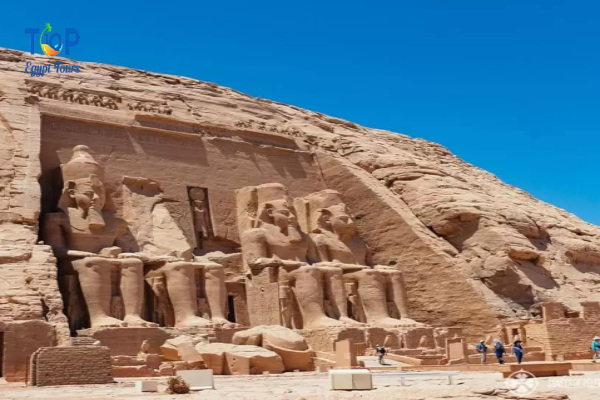Abu Simbel temples, also known as the Temple of Ramses II, are two massive rock-cut temples located in the village of Abu Simbel in Aswan Governorate, Upper Egypt. They are situated on the western bank of Lake Nasser, about 230 km southwest of Aswan.
In this article, we will uncover for you the Abu Simbel temples with Top Ten Egypt
The temples were built by the Egyptian pharaoh Ramses II (reigned 1279–13 BC) in the 13th century BC. They are dedicated to the gods Amun, Ra-Horakhty, and Ptah, as well as to the deified Ramesses himself.
The Great Temple of Ramses II is the larger of the two temples. It is 125 meters long and 60 meters high. The temple’s façade is dominated by four colossal statues of Ramses II, each seated on a throne and measuring over 20 meters high.
Inside the temple, there is a series of large halls and chambers, decorated with reliefs depicting scenes from Ramses II’s military campaigns and religious ceremonies. The most famous relief in the temple is the Battle of Kadesh relief, which depicts Ramses II’s victory over the Hittites in one of the largest chariot battles in history.
The Small Temple of Ramses II is located next to the Great Temple. It is dedicated to Ramses II’s queen Nefertari and the goddess Hathor. The temple’s façade is decorated with six colossal statues, four of Ramses II and two of Nefertari.
Inside the temple, there is a series of chambers decorated with reliefs depicting Ramses II and Nefertari worshiping the gods. The most famous relief in the temple is the Great Hypostyle Hall, which is supported by six massive pillars decorated with reliefs of Nefertari.
The Abu Simbel temples are one of the most popular tourist attractions in Egypt. They are a testament to the power and wealth of the ancient Egyptian pharaohs, and they offer visitors a unique glimpse into the religious beliefs and practices of ancient Egypt.
Uncover the wonders of Aswan and the majesty of Abu Simbel on an unforgettable 2-day journey to Aswan and Abu Simbel Temples.
What is the Abu Simbel Sun Festival?
The Abu Simbel Sun Festival is a celestial spectacle that occurs twice a year when sunlight miraculously illuminates the inner sanctum of the Abu Simbel Temple. This extraordinary alignment, intentionally designed by Ramses II, celebrates his ascension to the throne and his birthday.
Cultural Heritage Preservation:
The Abu Simbel temples were in danger of being submerged by the rising waters of Lake Nasser after the construction of the Aswan High Dam in the 1960s. In an international effort to save the temples, they were carefully dismantled and relocated to higher ground in 1968.
The relocation of the Abu Simbel temples was a remarkable feat of engineering. The temples were cut into over 2,000 blocks, which were then transported to their new location and reassembled. The temples were reopened to the public in 1972.
The Abu Simbel temples are a UNESCO World Heritage Site. They are a testament to the ingenuity of the ancient Egyptians and the importance of international cooperation in preserving cultural heritage.
Conclusion:
The Abu Simbel temples are a must-see for any visitor to Egypt. They are one of the most impressive and well-preserved ancient Egyptian temple complexes in the world. The temples offer visitors a unique glimpse into the religious beliefs, cultural practices, and artistic achievements of ancient Egypt.
Set an unforgettable Abu Simbel from Aswan Excursion to witness the awe-inspiring grandeur of one of Egypt’s most iconic treasures.



Comment (0)